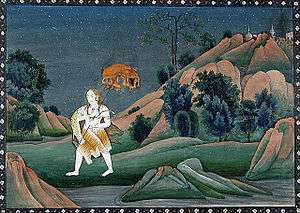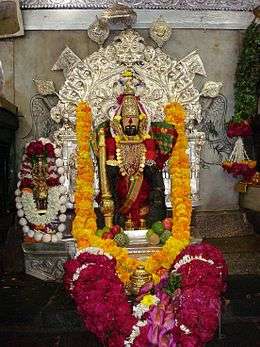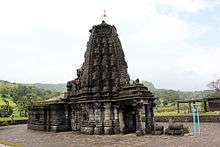Mahalakshmi Temple, Kolhapur
| Shri Mahalakshmi of Kolhapur | |
|---|---|
|
Shri Mahalakshmi Idol in the garbgruha of the shrine | |
 Shri Mahalakshmi of Kolhapur Location in Maharashtra | |
| Name | |
| Other names | आई अंबाबाई मंदिर |
| Proper name | Shri Mahalakshmi |
| Devanagari | श्री महालक्ष्मी देवस्थान |
| Kannada | ಶ್ರೀ ಮಹಾಲಕ್ಷ್ಮಿ |
| Tamil | ஸ்ரீ மகாலட்சுமி |
| Marathi |
श्री महालक्ष्मी (अंबाबाई) देवस्थान |
| Bengali | শ্রী মহালক্ষমি |
| Geography | |
| Coordinates | 16°42′00″N 74°14′00″E / 16.70000°N 74.23333°ECoordinates: 16°42′00″N 74°14′00″E / 16.70000°N 74.23333°E |
| Country | India |
| State/province | Maharashtra |
| District | Kolhapur |
| Locale | Mahadwar Road |
| Culture | |
| Primary deity | Vishnu mahaLakshmi |
| Important festivals | Navratri |
| History and governance | |
| Date built | 7th century |
The Shri Mahalakshmi (AmbaBai)[1] Temple of Kolhapur in Maharashtra, India, is one of the Shakti Peethas listed in various puranas of Hinduism. According to these writings, a Shakti Peetha is a place associated with Shakti, the goddess of power. The Kolhapur Shakti Peetha is of special religious significance being one of the six places where it is believed that one can either obtain salvation from desires or have them fulfilled. The temple takes its name from Mahalakshmi, the consort of Vishnu, and it is believed that the divine couple reside in the area.
The temple belongs architecturally to the Chalukya empire and was first built in the 7th century.[2] Mounted on a stone platform, the image of the four armed and crowned goddess is made of gemstone and weighs about 40 kilograms. The image of Mahalakshmi carved in black stone is 3 feet in height. The Shri Yantra is carved on one of the walls in the temple. A stone lion, the vahana of the goddess, stands behind the statue. The crown contains an image of the Sheshnag — the serpent of Vishnu. In Her four hands, the deity of Mahalakshmi holds objects of symbolic value. The lower right hand holds a mhalunga (a citrus fruit), in the upper right, a large mace (kaumodaki) with its head touching the ground, in the upper left a shield (khetaka), and in the lower left, a bowl (panpatra). Unlike most Hindu sacred images, which face north or east, the image of this deity looks west (Pashchim). There is a small open window on the western wall, through which the light of the setting sun falls on the face of the image for three days around the 21st of each March and September. There are a number of other shrines in the courtyard to the Navagrahas, Surya, Mahishasuramardini, Vitthal-Rakhmai, Shiva, Vishnu, Tulja Bhavani and others. Some of these images date back to the 11th century, while some are of recent origin. Also located in the courtyard is the temple tank Manikarnika Kund, on whose bank is a shrine to Visweshwar Mahadev.
Worship Structure: Five worship services are offered each day. The first one is at 5 am, and it involves the waking of the deity with a Kakada - torch, to the accompaniment of hymns. The second worship service at 8 am involves the offering of the Shodashopachara pooja consisting of 16 elements. The afternoon and evening services and the Shejaarati pooja constitute the three other services.
Special Events: A festival image of the deity is taken out in procession around the temple courtyard each Friday, and on full moon days.
Significance
It is said that both Shri Lakshmi and Shri Vishnu reside in the Karveer area eternally and shall not leave even at the time of Mahaprayakala. This region is therefore also referred to as an avimuktakshetra. Karveer region is eternally blessed and is believed to be held by Mother Jagdambe in her right hand, and so this region is protected from all destruction. Lord Vishnu himself adores this region more than Vaikiuntha or the Kshirsagar since it is the home of his consort Lakshmi. According to popular legends, Mahalakshmi left Vaikuntha and arrived at Kolhapur on hearing that Lord Venkatesh (Vishnu) her beloved husband failed to take action against sage Bhrigu for his horrific behaviour towards him. An angry Mahalakshmi is said to have observed strict penance in Kolhapur for several years until upon hearing the news of her husband being married to Tirumala Padmavati, another avatar of Mahalaskhmi. The greatness of this region has therefore attracted many sages and devotees, the blessings and affections showered by this region on its devotees are immeasurable. It is believed that Prabhu Shri Dattatreya still comes here every noon to seek alms.
The deity of the Goddess Mahalakshmi is made of gemstone and is considered to be at least 5000 to 6000 years old. It weighs about 40 kilos. The precious stones that adorn the deity indicate the antiquity of the deity. The platform of the Goddess Mahalakshmi is made of stone. The deity of the Goddess has four arms. In the lower right hand she holds the matulinga, (a fruit similar to and ordinary lemon but much larger in size). In the upper right hand she holds large mace, kaumodaks, its head touching the ground. In the upper left hand she holds the shield or khetaka, and while in the lower one she holds a bowl, panpatra.
On the crown of the Goddess Mahalakshmi are a cobra-hood and a Shiva-ling with a Yoni around it. Standing behind is the Goddess' vahana-a lion. Almost all the idols of the God face the north or the east directions, whereas here the Idol faces the west. The small window on the western wall which is open. Once a year, the rays of the Sun during sunset falls on the face of the image through this window. This period lasts for three days, each time, the 21st, of the months of March and September. This period is considered extremely auspicious, the Devotees throng the temple on all the three evenings the temple for a glimpse of the beautiful image bathing in the golden rays of the setting sun.
Mahalaxmhi had a fight with her husband and she settled in Kolhapur. She had no roof over her head, so her loyal servants, who were demons, built her a big temple with beautiful carvings made of stones from the lake Rankala within one night. The people treated her very well, and so she promised that there would be no poverty. No person in Kolhapur will remain poor. The temple is in the same condition.

Kirnotsav Celebrations
Kirnotsav in Mahalakshmi Temple Kolhapur (festival of Sun rays) is celebrated when the sun rays fall directly on the deity's Mahalakshmi murti at the time of sunset on the following days :
- 31 January & 9 November : Sun rays fall directly on the feet of the deity.
- 1 February & 10 November : Sun rays fall directly on the chest of the deity.
- 2 February & 11 November : Sun rays fall directly on the entire body of the deity.
Shri Peetham

The Kolhapureshwari temple is reverred as a Shakti Peetha, well known as Shri Peetham. Shakti Peethas are highly revered shrines of Shakti by the Saktha sect (Shaktism) of Hinduism. The mythology of Daksha yaga and Sati's self immolation is the story of origin for the Shati Peetha temples. They are believed to have formed when the body parts of Sati Devi fell while Shiva was carrying her corpse after her death. Sati Devi's Eyes are believed to have fallen here. Like each Shakti Peetha an associated Kalabhairava Shrine is present in the temple.[3][4][5][6]
Festival
It is not surprising that even the rays of a setting sun pay homage to Goddess Mahalakshmi as the life of human being revolves around illumination and prosperity. But it is the wonder of wise architects who built the temple of Mahalakshmi at kolhapur that the rays of the setting Sun, bow at the feet of the Goddess through a window, for a while before vanishing. This special event is celebrated by thousands of people as ‘KiranUtsav’. Every year this festival is celebrated on the following days at evening: 31 January 1 February 2 February 9 November 10 November 11 November
It is said that Sun god gives respect to Mahalaxmi for three days in a year. This will be on the occasion of RathaSaptami (which will be during January every year). This will be for 3 days. The first day, ray falls on the feet, on second day, on the middle portion of the deity and on the third day on the face. It is the architect's excellence, which was done more than 1000 years ago, and can still be observed. Later during the time of Peshwas, the temple was repaired. Though many invasions over this part of India have caused some damages of the beautiful idols which are all around the temple.
History
The city is referred in many Puranas. Research guesses that it was in existence in the times of Parashuram. The time is considered parallel to that of Mata peeth (Mahurgad), Sapta Shringi (Nasik) and Bhavani Peetha, in the Ramayana times. Karveer washes off great sins. There are many ancient, rich temples, holy places and gardens.
There is evidence to show that the Konkan king Kamadeo, Chalukyas, Shilahara, Yadavas of devagiri dynasties visited this city. Adya Shankaracharya also visited. Chhatrapati Shivaji Maharaj & Sambhaji reigned. The idol of Mahalaxmi is made of jewel - stone, approximately weighing 40 kg. The size is like Salunki. Sand & diamond are found in it. It stands on a stony stage with a lion behind it. In the middle there is natural lotus. It is four-handed, having Vetak, shield, Mhalung & Water-Pot. There is crown on the head and a snake holds shade.
In 109 A. D. Karnadeo cut off the jungle and brought the temple to light. The existence goes back to the 8th century, according to Dr. Bhandarkar & Mr. Khare. In the 8 th century, the temple sank down due to earthquake. In the 9th century Gandavadix (King) extended the temple by building Mahakali Mandir. During 1178–1209, in the reign of Raja Jaysing & Sindhava, South gate & Atibaleshwar Temple were built. In 1218 Yadav king Tolum built Mahadwar, and offered jewels to Devi. Further, Shilaharas built Maha Sarasvati Mandir. He being a Jain, got 64 idols carved. It is possible that new idol called Padmavati was installed at that time. Further, in Chalukya times, Ganapati before the temple was installed. It seems that the original temple was of the Hindus. In the 13th century, Shankaracharya built Nagar Khana & Office, Deepmalas.
During 1712–1792 (Sambhaje Reign) Narhar Bhat Shastree had a dream which he told to Sambhajee. In the Mogal reign, the worshippers had hidden the idol for protection. Believing Sangavakar's dream, Sambhajee started a search. This idol was found in a house in Kapil Teerth Market. According to Sambhaji's letter dated 8 November 1723, Sindhoji Hindurao Ghorpade of Panhala installed the idol again on 26 September 1712 (Monday, Ashwin Vijiya Dashami). The number of devotees grew, and in due course of time, the Devi became the Deity of Maharashtra. The idol began to denude due to Abhishekas. So Sankeshwar Shankaracharya got it repaired. After Vajralep & sacrifices, it was again installed at the hands of Kolhapur Shahajee Raje in 1954.In 1964, there was transformation under the supervision of Mr. Lohiya. As a result, the premises seemed extensive. There are 5 main temples and 7 Deepamalas now. Around are 35 temples of various sizes and 20 shops. There are 5 Hemad-style tops. Adjoining is Garud Mandap, built by Mr. Harshe.
References
- ↑ "अंबाबाई मूर्तीवरील नागमुद्रेचा विसर" [Ambābā'ī mūrtīvarīl nāgamudrēcā visar]. Maharashtra Times (in Marathi). Kolhapur. 6 August 2015. Retrieved 13 September 2015.
- ↑ Karen Tate (2006). Sacred Places of Goddess: 108 Destinations. CCC Publishing. p. 196.
- ↑ http://www.mahalaxmikolhapur.com/index.php?option=com_content&view=article&id=22&Itemid=55
- ↑ (Translator), F. Max Muller (June 1, 2004). The Upanishads, Vol I. Kessinger Publishing, LLC. ISBN 1419186418.
- ↑ (Translator), F. Max Muller (July 26, 2004). The Upanishads Part II: The Sacred Books of the East Part Fifteen. Kessinger Publishing, LLC. ISBN 1417930160.
- ↑ "Kottiyoor Devaswam Temple Administration Portal". http://kottiyoordevaswom.com/. Kottiyoor Devaswam. Retrieved 20 July 2013. External link in
|work=(help)
www.mahalaxmitoday.com



